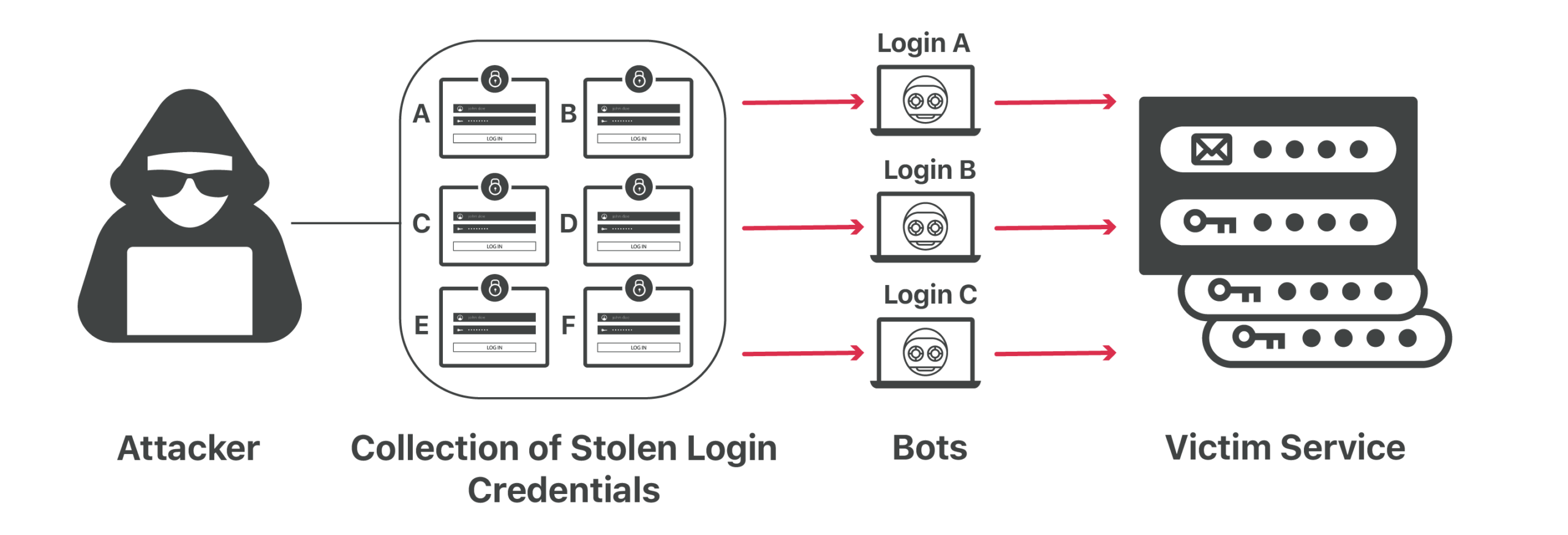In a credential stuffing attack, collections of stolen login credentials from one service are used to attempt to break into accounts on various other services.
What is Credential Stuffing?
Credential stuffing is a cyber attack in which credentials obtained from a data breach on one service are used to attempt to log in to another unrelated service.

For example, an attacker may take a list of usernames and passwords obtained from a breach of a major department store and use the same login credentials to try and log in to the site of a national bank. The attacker is hoping that some fraction of those department store customers also have an account at that bank and that they reused the same usernames and passwords for both services.
Credential stuffing is widespread thanks to massive lists of breached credentials being traded and sold on the black market. The proliferation of these lists and advancements in credential-stuffing tools that use bots to get around traditional login protections have made credential-stuffing a popular attack vector.
What makes credential stuffing effective?
Statistically speaking, credential-stuffing attacks have a very low rate of success. Many estimates have this rate at about 0.1%, meaning that for every thousand accounts, an attacker attempts to crack, they will succeed roughly once. The sheer volume of credential collections being traded by attackers makes credential stuffing worth it, despite the low success rate.
These collections contain millions and in some cases, billions of login credentials. If an attacker has one million sets of credentials, this could yield around 1,000 successfully cracked accounts. If even a tiny percentage of the cracked accounts deliver profitable data (often in the form of credit card numbers or sensitive data that can be used in phishing attacks), then the attack is worthwhile. On top of that, the attacker can repeat the process using the same credentials on numerous different services.
Advances in bot technology also make credential stuffing a viable attack. Security features built into web application login forms often include deliberate time delays and banning the IP addresses of users who have repeated failed login attempts. Modern credential-stuffing software circumvents these protections by using bots to simultaneously attempt several logins that appear to come from various device types and originate from different IP addresses. The malicious bot’s goal is to make the attacker’s login attempts indistinguishable from typical login traffic, and it’s very effective.
Often the only indication the victimized company has that they are being attacked is the rise in the overall volume of login attempts. Even then, the victimized company will have difficulty stopping these attempts without impacting the ability of legitimate users to log in to the service.
The main reason that credential stuffing attacks are effective is that people reuse passwords. Studies suggest that most users, by some estimates as high as 85%, reuse the same login credentials for multiple services. As long as this practice continues, the credential stuffing will remain fruitful.
What’s the difference between credential stuffing and brute force attacks?
OWASP categorizes credential stuffing as a subset of brute force attacks. But, strictly speaking, credential stuffing differs from traditional brute force attacks. Brute force attacks attempt to guess passwords with no context or clues, using characters at random, sometimes combined with common password suggestions. Credential stuffing uses exposed data, dramatically reducing the number of possible correct answers.
A good defense against brute force attacks is a strong password consisting of several characters, including uppercase letters, numbers, and special symbols. But password strength does not protect against credential stuffing. It doesn’t matter how strong a password is – if it’s shared across different accounts, then credential stuffing can compromise it.
How to prevent credential stuffing
How users can prevent credential stuffing
From a user’s point of view, defending against credential stuffing is pretty straightforward. Users should always use unique passwords for each service (an easy way to achieve this is with a password manager). If a user always uses unique passwords, the credential stuffing will not work against their accounts. As an added security measure, users are always encouraged to enable two-factor authentication when available.
How companies can prevent credential stuffing
Stopping credential stuffing is a more complex challenge for companies that run authentication services. Credential stuffing occurs as a result of data breaches at other companies. A company victimized by a credential stuffing attack has not necessarily had its security compromised.
A company can suggest that its users provide unique passwords but cannot effectively enforce this as a rule. Some applications will run a submitted password against a database of known compromised passwords before accepting the password as a measure against credential stuffing. However, this isn’t foolproof – the user could be reusing a password from a service yet to be breached.
Providing added login security features can help mitigate credential stuffing. Enabling features like two-factor authentication and requiring users to fill out captchas when logging in also help stop malicious bots. While these features inconvenience users, many agree that minimizing the security threat is worth the inconvenience.
The strongest protection against credential stuffing is a bot management service. Bot management uses rate limiting combined with an IP reputation database to stop malicious bots from making login attempts without impacting legitimate logins.












